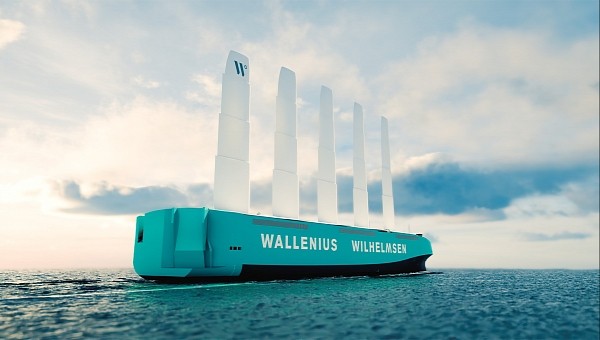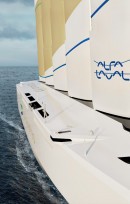One of the ways to reduce CO2 emissions related to shipping is by harnessing the power of wind. Not in the traditional way, but with help from the latest technology, for increased performance. This is how several innovative sailing concepts were developed over the past few years. Oceanbird is one of the best.
A few years ago, Wallenius Marine unveiled a revolutionary sailing system, called Oceanbird. Together with another industry partner, Alfa Laval, Wallenius intends to build a pioneering cargo vessel, fitted with Oceanbird system, that would become the tallest ship in the world. That’s because the Oceanbird is comprised of 80 meters (262 feet) of wing sails, which makes it twice as tall as the masts on the largest vessels today.
With a total height above the waterline of 105 meters (344 feet), the future car carrier would be the tallest ship in the world, yet this wouldn’t stop it from reaching any specific harbor, due to the fact that this modern sail system is telescopic, so that it can be easily lowered when needed. In terms of performance, thanks to this sailing system, the future car carrier with up to 7,000 vehicles onboard, would be able to cross the Atlantic in 12 days, traveling at 10 knots (11.5 mph/18.5 mph).
However, one of the biggest benefits of this innovative concept is that it’s flexible enough to be installed on existing vessels as well. Oceanbird is not just about building a different kind of car carrier altogether, but also about making a drastic change in terms of emissions, as soon as possible. This can only be done by retrofitting ships in today’s commercial fleets – something that’s also being done in aviation.
The Swedish company will start things off with the retrofit of a Wallenius Wilhelmsen vessel, during drydocking, which will include the installation of a test rig. The Oceanbird Wing 560 is comprised of a main sail and a flap, which help improve aerodynamic performance.
Wallenius claims that a RoRo (Roll On, Roll Off) vessel fitted with one wing sail, and cruising at normal speed, will reduce fuel consumption by up to 10% and at least 7%, in the best conditions (by choosing favorable routes for sailing). This would be the equivalent of 675,000 liters of diesel per year, and nearly 2,000 tonnes of CO2 annually.
Plus, the Oceanbird Wing 560 is made with recycled materials (as much as possible) to increase sustainability further.
By the end of this year, Wallenius hopes to complete a full-scale land-based installation of the Oceanbird Wing 560 concept. Next, by the end of 2024, the Wallenius Wilhelmsen vessel Tiranna will be successfully retrofitted with the sailing system, and ready to start operating. The retrofit process is carried out as part of a European project called Horizon, supporting green shipping.
With a total height above the waterline of 105 meters (344 feet), the future car carrier would be the tallest ship in the world, yet this wouldn’t stop it from reaching any specific harbor, due to the fact that this modern sail system is telescopic, so that it can be easily lowered when needed. In terms of performance, thanks to this sailing system, the future car carrier with up to 7,000 vehicles onboard, would be able to cross the Atlantic in 12 days, traveling at 10 knots (11.5 mph/18.5 mph).
However, one of the biggest benefits of this innovative concept is that it’s flexible enough to be installed on existing vessels as well. Oceanbird is not just about building a different kind of car carrier altogether, but also about making a drastic change in terms of emissions, as soon as possible. This can only be done by retrofitting ships in today’s commercial fleets – something that’s also being done in aviation.
The Swedish company will start things off with the retrofit of a Wallenius Wilhelmsen vessel, during drydocking, which will include the installation of a test rig. The Oceanbird Wing 560 is comprised of a main sail and a flap, which help improve aerodynamic performance.
Wallenius claims that a RoRo (Roll On, Roll Off) vessel fitted with one wing sail, and cruising at normal speed, will reduce fuel consumption by up to 10% and at least 7%, in the best conditions (by choosing favorable routes for sailing). This would be the equivalent of 675,000 liters of diesel per year, and nearly 2,000 tonnes of CO2 annually.
Plus, the Oceanbird Wing 560 is made with recycled materials (as much as possible) to increase sustainability further.
By the end of this year, Wallenius hopes to complete a full-scale land-based installation of the Oceanbird Wing 560 concept. Next, by the end of 2024, the Wallenius Wilhelmsen vessel Tiranna will be successfully retrofitted with the sailing system, and ready to start operating. The retrofit process is carried out as part of a European project called Horizon, supporting green shipping.










